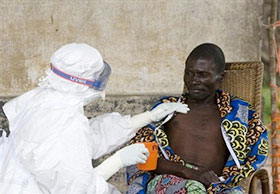Current Talmud Passage
Posted October 18, 2014 by Rabbi Judy Abrams. Copyright © 2014 Judith Z. Abrams
Ebola: A Perfect Time to Study Leviticus and Numbers
BH
Now that the news is filled with stories about Ebola and, more specifically, Nancy Snyderman’s breaking the quarantine rule, it’s the perfect time to study some passages in Leviticus and Numbers.
All those chapters about “leprosy” (scale disease) and ritual impurity of houses, chairs, clothes and persons can make a great deal of sense. On a visceral level, the Torah understands contagion and the fear associated with it, even though it did not have any understanding of germ theory. The sages of the Talmud did not even know about blood circulation or the functions of many of the organs.
But they did understand frightening disease and that it was communicable. The greater the longer the interval between contact with the disease and its manifestation, the more frightening it was. And a disease that attacks one visibly was doubly frightening. Scale disease (“leprosy”) makes a person look like they are dying bit by bit. So, for example, when Miriam is stricken with “leprosy” she looks like “one with half its flesh eaten away (Numbers 12:12).”
Ebola is scarcely less frightening: blood that should stay inside the body is suddenly outside the body. Temperature, which should remain steady, spikes. Food, which should be digested, is excreted violently. And, currently, not much can be done about it. “Leprosy”, like Ebola, does not care if your intentions are pure. That is part of the fear associated with it, too.
How do we declare that someone is ready to be reincorporated into society? We have them go through the purification ritual outlined in Leviticus, chapter 14. It is amazingly similar to what we do with Ebola patients. The priest (physician) gives the person a check up, dispatches all the waste materials that might be infected with the disease to a faraway place (hazmat or “the wilderness (Leviticus 14:7)”) and declares the person fit to rejoin society (either with a clean bill of health or by offering a sacrifice (Leviticus 14:10-11)).
Discussion Questions:
- What else can we learn from Leviticus about how to deal with Ebola? Should we create a ritual that reassures everyone that a zone/person is contagion-free? If we modeled it on Leviticus 14, how would we adapt it? Should a person be part of a public ceremony in which their reincorporation into the community is affirmed?
- Is it amazing that, for all our medical advances, so little has changed on the emotional level when it comes to a contagious, deadly disease? How might we better handle our feelings about this disease? How can we maintain our humanity in the face of Ebola? In other words, how can we best be non-anxious in the presence of our enormous anxiety?
May the “priests” of today (physicians and scientists) create an effective ritual (vaccines and treatments) that will allow us to reincorporate those who have been afflicted with this disease into society speedily.

Learn With Rabbi Abrams
If you like the website, you'll love learning with Rabbi Abrams in person even more! She can come to your synagogue or group as a scholar-in-residence or you can learn with her long distance via phone or Skype. You can also have her teach single lectures to your group. Click here for a list of just a few of the talks available.
Maqom is now also a discussion group, Maqom613, at Google groups where you can read the discussions and post your own comments. If you are a current member or wish to participate, you can sign in or join the Maqom613 group here. New members will need a gmail account to log in, which you can create when you sign up to join the group if you do not yet have an account.
